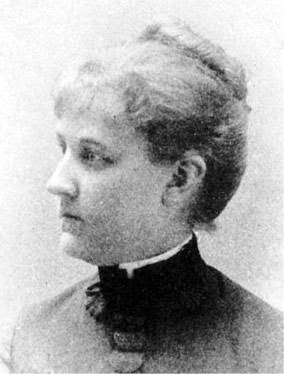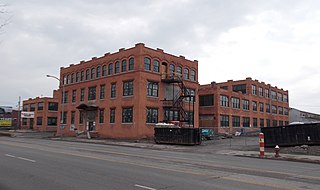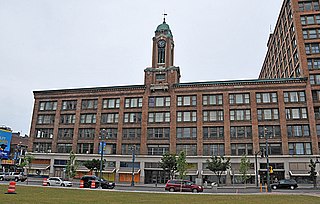
The Historic Third Ward is a historic warehouse district located in downtown Milwaukee, Wisconsin. This Milwaukee neighborhood is listed on the National Register of Historic Places. Today, the Third Ward is home to over 450 businesses and maintains a strong position within the retail and professional service community in Milwaukee as a showcase of a mixed-use district. The neighborhood's renaissance is anchored by many specialty shops, restaurants, art galleries and theatre groups, creative businesses and condos. It is home to the Milwaukee Institute of Art and Design (MIAD), and the Broadway Theatre Center. The Ward is adjacent to the Henry Maier Festival Park, home to Summerfest. The neighborhood is bounded by the Milwaukee River to the west and south, E. Clybourn Street to the north, and Lake Michigan to the east.

Louise Blanchard Bethune was the first American woman known to have worked as a professional architect. She was born in Waterloo, New York. Blanchard worked primarily in Buffalo, New York and partnered with her husband at Bethune, Bethune & Fuchs.

The Mentholatum Company, Inc. is a maker of non-prescription health care products founded in 1889 by Albert Alexander Hyde in the United States. It was bought out by Rohto Pharmaceutical Co., a Japanese health care company, in 1988. The Mentholatum Company is known for its top three products, Mentholatum Ointment, Mentholatum Deep Heating Rub, and Mentholatum Lip Care. The Mentholatum Building in Buffalo, New York was listed on the National Register of Historic Places in 2017.

Jobbers Canyon Historic District was a large industrial and warehouse area comprising 24 buildings located in downtown Omaha, Nebraska, US. It was roughly bound by Farnam Street on the north, South Eighth Street on the east, Jackson Street on the south, and South Tenth Street on the west. In 1989, all 24 buildings in Jobbers Canyon were demolished, representing the largest National Register historic district loss to date.

The Cass Park Historic District is a historic district in Midtown Detroit, Michigan, consisting of 25 buildings along the streets of Temple, Ledyard, and 2nd, surrounding Cass Park. It was listed on the National Register of Historic Places in 2005 and designated a city of Detroit historic district in 2016.

The Wason-Springfield Steam Power Blocks are a collection of three historic commercial blocks at 27-43 Lyman St. and 26-50 Taylor Street in downtown Springfield, Massachusetts. They were built in the 1870s by the J.W. Wason Car Company and the Springfield Steam Power Company as facilities to support the development of new businesses in what was then called the North Blocks area of the city.

The Friedrich Block is a historic mixed-use commercial and residential block at 449-461 Main Street in Holyoke, Massachusetts. Built in 1908, it is a significant Renaissance Revival work by the local architect George P. B. Alderman, and for its association with the E.H. Friedrich Company, a manufacturer of metal architectural parts. The building was listed on the National Register of Historic Places in 2002.

The West Vernor–Lawndale Historic District is a two-block commercial historic district located along West Vernor Highway between Cabot and Ferris Streets in Detroit, Michigan. The district includes 30 acres (120,000 m2) and 10 buildings. It was listed on the National Register of Historic Places in 2002.

The Jefferson–Chalmers Historic Business District is a historic district located on East Jefferson Avenue between Eastlawn Street and Alter Road in Detroit, Michigan. The district is the only continuously intact commercial district remaining along East Jefferson Avenue, and was listed on the National Register of Historic Places in 2004.

The Warsaw Courthouse Square Historic District is a historic district in Warsaw, Indiana that was listed on the National Register of Historic Places in 1982. Its boundaries were increased in 1993.

Trico Plant No. 1 is a historic windshield wiper factory building located in Buffalo, New York. It is an example of a style of architecture sometimes referred to as the daylight factory, a style for which Buffalo is well known. The building was mostly constructed in the 1920s and 1930s of reinforced concrete and features curtain walls of metal sash windows and brick spandrels, although a portion of the plant incorporates an historic brewery building from the 1890s. It was the original home of Trico Products Corporation, the first manufacturer of windshield wipers, and was an important factory during a period when Trico was the largest employer in the city of Buffalo. The building is also known for once being the office of John R. Oishei (1886–1968), the company's founder and an industrialist who went on to become one of the most important philanthropists in the Buffalo Niagara Region.

E. & B. Holmes Machinery Company Building, also known as The Cooperage, is a historic factory building located at Buffalo in Erie County, New York. It is a roughly rectangular brick building composed of three primary sections of four-, three-, and two-stories, which encircle a central courtyard. The three sections are the Mill Building, Forge Building, and Pattern Building (1913). The E. & B. Holmes Machinery Company revolutionized the barrel making industry by patenting the design and manufacturing of machinery used for mass-producing barrels. The company operated from 1840 until 2002.

The Ficke Block is a historic building located in downtown Davenport, Iowa, United States. It was individually listed on the National Register of Historic Places in 1983. In 2020 it was included as a contributing property in the Davenport Downtown Commercial Historic District.

Poughkeepsie Underwear Factory is a historic factory building located at Poughkeepsie, Dutchess County, New York. It was built in 1874 and is a 3 1⁄2-story, eight-bay brick building. It was expanded about 1887.

Dick Block is a historic commercial building located at North Tonawanda in Niagara County, New York. It was built in 1891 and is a three-story, three bay, red brick building in the Romanesque Revival style. It features rounded windows and arches, rusticated stone detailing, and ornamental brickwork. The first floor storefronts were modernized about 1946, when the building was occupied by the Witkop and Holmes Company furniture store.

F.N. Burt Company Factory is a historic former box factory complex located at Buffalo in Erie County, New York. Another factory operated by F.N. Burt in Buffalo was the F.N. Burt Company Factory "C".
Ellicott Development Co. is an American property management, leasing and development real estate firm based in Buffalo, New York and led by CEO William Paladino. The company's asset base includes residential, commercial, hotels, parking garages, and convenience stores. Ellicott Development Co.’s services include legal, administrative, financial, management, accounting, development, site selection, site assemblage, architectural design and drafting services, construction, leasing, maintenance, janitorial and security services.

Taylor Signal Company-General Railway Signal Company is a historic industrial complex located in Buffalo, Erie County, New York. It was designed by the architectural firm of Esenwein & Johnson and built between 1902 and 1906. The daylight factory complex consists of a rectangular two and three-story brick factory building with a central light court and wings. It has a three-story brick office building fronting on Elmwood Avenue and connected to the factory by a hyphen. The office building features Gothic Revival style design elements. The complex housed the Taylor Signal Company/General Railway Signal Company until 1907, when operations were moved to Rochester, New York. Afterwards, it housed a number of manufacturing companies including the Century Telephone Construction Company, General Drop Forge Company, Curtiss Aeroplane and Motor Company, and Lippard-Stewart Motor Car Company. The complex has been renovated to house a hotel, banquet facility, and loft apartments.

Sibley's, Lindsay and Curr Building is a historic commercial building located at Rochester in Monroe County, New York. It was designed by noted Rochester architect J. Foster Warner and built for Sibley's in 1904. The original wing of the building was constructed in 1906 as a five-story, Chicago school style skeletal steel building sheathed in brown Roman brick with deeply set Chicago style windows, topped by a clock tower with Baroque and Renaissance style details. Additions were made to the building in 1911 and 1924, including a 12-story tower section.

The Robinson and Swan Blocks are a pair of mixed commercial-residential buildings at 104-108 Pleasant Street and 1-3 Irving Street in Worcester, Massachusetts. Built about 1884 to nearly identical designs by Fuller & Delano, the buildings are well-preserved examples of Victorian Gothic architecture executed in brick. They were listed on the National Register of Historic Places in 1980, but due to administrative lapses, are not listed in its NRIS database.
























